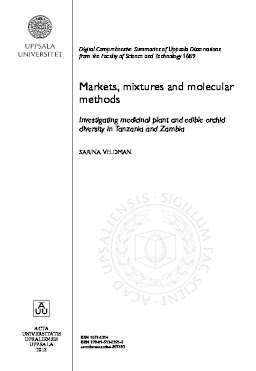2018
Markets, mixtures and molecular methods: investigating medicinal plant and edible orchid diversity in Tanzania and Zambia
Publication
Publication
Medicinal plants are an important source of primary healthcare for many people in Tanzania. These medicinal plants are harvested from the wild, and increasing commercial trade poses a serious threat to local plant populations. Currently it is unknown which species are traded and in what amounts. Across the southwestern border in Zambia, the traditional dish chikanda has transformed from a niche product to being a mainstream delicacy. One of the main ingredients are wild-harvested orchids, and these have become depleted throughout the country as an effect of the increased trade. It is unclear which orchid species are targeted and might be at risk of overharvesting. The aims of my doctorate are to map harvest and trade of Tanzanian medicinal plants and Tanzanian and Zambian edible orchids, to investigate whether species that are traded on local markets can be identified using molecular methods such as DNA barcoding and metabarcoding and identify conservation issues arising from wild-harvesting of medicinal plants and edible orchids. In Paper I DNA metabarcoding analysis of Tanzanian chikanda cake show the presence of 17 different orchids species belonging to the genera Disa, Satyrium and Habenaria, and in Paper V the analysis of chikanda tubers sold on Zambian markets reveals that at least 16 orchid species from 6 different orchid genera are targeted in local orchid trade. Paper II describes a quantitative market survey of the non-woody, non-powdered medicinal plants sold on Kariakoo market in Dar-es-Salaam that shows that a total of 67 species are traded in an annual volume of nearly 31 tonnes of fresh and dried medicinal leaves, seeds and fruits with an estimated value of 200,000 USD. For Paper III 873 medicinal plant products were analysed using DNA barcoding, literature and morphology to determine which species are traded on the Dar-esSalaam and Tanga markets. In total, 509 identifications could be made corresponding to 91 species, 124 genera and 65 plant families, and several cases of over- and under-differentiation were detected. Paper IV builds upon the identifications in Paper III to determine in what amount the medicinal plant species present at the local markets are traded and to investigate if commercial trade poses a threat to local plant populations. It was found that several of the most highly favored medicinal plants were perceived to becoming more difficult to obtain in the wild. This thesis shows that DNA barcoding is a powerful rapid identification method for morphologically unidentifiable specimens. It also shows that commercialization of wildharvested plant products threatens local plant populations, and highlights the need for conservation measures to avoid local extinction of economically and socially important plant species.
| Additional Metadata | |
|---|---|
| , , , , | |
| Acta Universitatis Upsaliensis, Uppsala | |
| Organisation | Staff publications |
|
Veldman, S. (2018, January). Markets, mixtures and molecular methods: investigating medicinal plant and edible orchid diversity in Tanzania and Zambia. Acta Universitatis Upsaliensis, Uppsala. |
|
